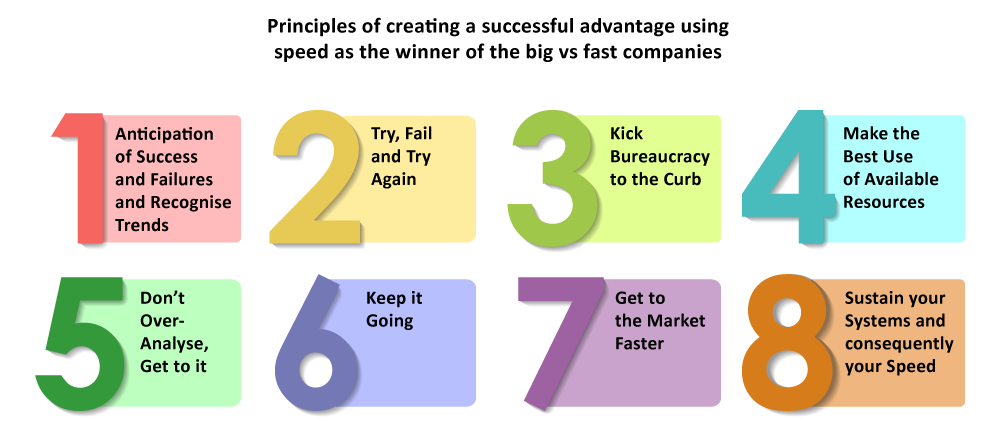
Over decades, It has become more evident that in the fight between big vs fast companies, speed and agility have contributed significantly to organizational success. Yes, it is not the only factor that determines business competency but it is definitely one of the factors that can be used as a competitive tool in business.
Additionally, it has been observed that speed outdoes the size of the organization. Companies that have become big but have not maintained their innovation speed on a consistent basis have sunk.
We will discuss certain cases of how speed was used to defeat giants in the industry.
It has become more and more evident over decades that in the fight between big vs fast companies, speed and agility have contributed significantly to organizational success.
The conceptual basis of study
In Malcolm Gladwell’s book “David and Goliath”, the dilemma of big vs fast is explained as the competitive advantage of the underdog. David, an athletic and fast teenager, battles Goliath, a strong, extremely large unchallenged giant.
Previously, swords were used in fights, but David brought a sling to the fight and won. The author explains how the sling depicts new technology, and David’s speed aided in his victory.
Another example of the concept is the 1980 Olympic Finals of Ice Hockey between the USA and USSR, where the USA’s young team defeated the previously undefeated Russian team using new tactics, speed, and improvisation.
Big vs Fast Companies: Who Won?
1. Netflix and Blockbuster
One of the best examples of big vs fast companies is that of Blockbuster and Netflix. Netflix revolutionalized the industry by being a small start-up that eventually overtook Blockbuster. They did this with speed, agility, and innovation.
Blockbuster was a brick-and-mortar company that started in 1985 and grew from one store in Texas to three thousand stores in 1992. Netflix started as an online service for movie rentals in 1997.
Netflix brought change to the business model that Blockbuster had; no late charges were required. Instead, a monthly subscription fee was to be paid. Netflix even approached Blockbuster to possibly handle the online side of their business, an offer which was declined by Blockbuster as they were of the opinion that Netflix was too small a player.
Blockbuster was massive, with a high brand value and financial strength. Netflix, on the other hand, was not very well known but managed to grow its market share due to its fast-changing tactics, innovation, and agility.
Eventually, blockbuster had to try and reach up to their level, which they were not able to achieve, and ended up filing for bankruptcy in 2010, with Netflix being ten times their worth in 2014.
Today, Netflix continues to innovate. It has emerged as a streaming platform that curates content to compete with giants in the industry, such as Disney, Universal, 20th Century Fox, etc.
2. Salesforce and Siebel
Another great example of big vs. fast companies is Siebel and Salesforce. Siebel was one of the largest CRM software companies in the world. It got acquired by Oracle in 2005 at $6 billion dollars. At the time, their market share is 20%. They had a particular business model that was geared toward the enterprise.
Salesforce entered the market with flexible pricing and configurations, thus changing the way business software was sold. In 2005, the revenue of Salesforce was $176 million dollars, while Siebel’s revenue was $1.5 billion dollars.
In 2019, Siebel’s division of Oracle revenue $160 mil dollars and 0.5% market share. It became 1/10th of its size. In the same period, Salesforce grew to have a revenue of $13 billion dollars.
Salesforce is the David that became a platform company that provided a service and continues to innovate. They were fast, agile, and defined the market instead of just reacting to it, while Siebel is the giant who fell.
3. Indigo and Jet Airways
The chairman of Jet Airways, Mr. Naresh Goel, had mentioned that low-cost carriers could not compete with Jet Airways as they have their own markets.
Indigo changed the game with the innovation of their
- Operations
- Business and Financial model
- Acquisition and Maintenance of Inventory and Assets
- Marketing Strategy
- Staff Training
They made sure they were fast; they would employ new tactics very quickly.
The moral here is that small companies were able to beat very large ones using rapid innovation, adaptability, and speed.
Also read: 5 Ways to Achieve Success with No-code Low-Code
Big vs Fast companies: Does size affect speed?
1. Amazon
Amazon emerged as a giant but is still constantly changing itself. They keep growing, expanding into different areas, innovating, and creating new spaces.
Amazon Prime, for example, the first version of Prime, was created at the end of 2004; a month and a half later, It went live on the 2nd of February, 2005.
Their business sense is very fast as they adapt quickly and create new models. They are building their brand’s ecosystem.
2. Apple
Apple continually challenged the status quo. Their slogan, “Think different,” redefined the speed and pace at which businesses could alter themselves. When Apple was the stock market’s favorite, Steve Jobs said that Apple is the largest startup.
Their speed is truly brilliant. An example of it is the iPod which was shipped within nine and a half months of its initiation.
Apple’s slogan “think different” redefined the speed and pace at which a business could alter themselves.
The moral here is that size does not matter. No matter how big your company gets, you should always be fast.

Companies that got to the market fast
Those companies that have reached the market fast have succeeded in grasping a chunk of the market share.
1. Airbnb
The sheer size of inventory and the shared economy model drove Airbnb to be one of the most successful companies.
Its listings are more than that of the four mega hotel chains in the world combined. With the pace at which Airbnb is growing, it will soon catch up with Marriot, which is undefeated due to its acquisition of the Starwood properties.
Airbnb has an unorthodox business model. Speed and adaptability are strong suits.
2. Jio
Jio was extremely fast when it entered the market. Competitors like Airtel and Idea were struggling to keep up. Now that Jio has acquired a significant market share, they have allowed Airtel and Idea to catch up.
Jio continues to innovate at a fast pace and has acquired many startups and integrated them into Jio platforms.
It’s important to understand that those companies that become large and stop innovating or adapting will definitely fall, especially today. Being fast is important, but that is different from being hasty, which is counter-productive.
Leveraging Speed to Cater to Instant Gratification Culture
Consumers have grown to crave instant gratification, which is what businesses are catering to. Speed is a very useful tool in leveraging this desire for instant gratification and creating a competitive advantage in the market.
The understanding of big vs fast companies has been explained very well in Jason Jenning’s book, “It’s Not the Big That Eats the Small…It’s the Fast That Eats the Slow.”
Using speed has therefore become essential. There are several principles of creating a successful advantage using speed as the winner of the fight between big vs fast companies; they are:

1. Anticipation of Success and Failures and Recognise Trends
In understanding big vs fast companies, proper anticipation and spotting of trends is important. To anticipate properly, successful communication and empathy are essential. Understanding the target market and recognizing trends is very helpful so as to convert intuition into a product.
For example, Fabian Manson, the former CEO of H&M, fills the gap in every matter of financial performance. His unconventional business model involved the designers sitting in bars and pubs and clubs, observing rock concerts, observing parents with their kids, attending sporting events, and looking for new combinations rather than attending fashion shows.
Delving into the minds of the target market and not only knowing what they want but liking what they like is essential; after this, speed is a result of fast thinking.
2. Try, Fail, and Try Again
Failures have to be anticipated so as to come up with mechanisms to make sure they are controlled and have minimal impact on the working of the organization. This increases the chances of success. Goals should not be overestimated, and resources should not be underestimated.
Goals should not be overestimated and resources should not be underestimated.
When failures occur, which they definitely will, learning from them is important. Otherwise, you will get stuck in a cycle of repeated mistakes.
Setbacks are inevitable. Success comes from the lessons taught by setbacks.
3. Kick Bureaucracy to the Curb
In the big vs fast companies feud, fast beats the bureaucracy. A lot of potentially great ideas suffer fates of being hijacked, the idea giver faces discouragement, or someone who feels threatened decides that the idea has no merit. This greatly affects the direction and speed of working.
Big ideas innovation comes from the top because that’s where the resource is and that’s where the power to say yes exists
EVELYN DILSAVER, SENIOR VP OF CHARLES SHWAB
A good company’s leaders must ensure that their ego is put aside for ideas and inspiration to arrive from anywhere in the organization. An organization needs to be collaborative, not authoritarian. Human capital defines a company; fast thinking cannot be achieved if people’s voices are not heard.
Decisions cannot be centralized; they must be made by the concerned departments. There cannot be paralysis in the analysis of decisions. Bureaucratic structures are unnecessary and must be destroyed quickly and efficiently. Waiting for consensus on every decision slows down the organization.
4. Make the Best Use of Available Resources
Time, effort, and energy are required to understand the usage of the right digital transformation tools. This is ultimately worth it. Digital tools like AI, RBA, and low-code no-code are very helpful.
Owning and exploiting your competitive advantage can also be very beneficial so as to not rely on others.
For example, in 1979, Charles Shwab purchased the beta system for $5,00,000, which was equal to the net worth of the entire company at the time. Post this; the software was needed. Soon, Shwab had an in-house tech team creating products. Some were blunders, but others were big successes. In 1996, e. Shwab was launched, which expected 25000 customers in the first year; they got that in a month.
Besides this, it is important to ask questions to understand the motives and the best and worse case scenarios; every outcome should be considered to make decisions. Frequently shuffle portfolios to enable fresh perspectives. Stepping out of their comfort zones is important to keep people on their toes.
Also read: Top Digital Transformation Quotes to Lead Growth for Your Business
5. Don’t Over-Analyse; get to it
In big vs fast companies, action has to be taken to generate results. Get work done instead of wondering what would happen if you got work done. This is possible if the same sentiment is shared throughout the organization; speed is a byproduct of motivation to achieve goals.
Invite other fast people to join your crusade, your vision, rather than just offering jobs. This will ensure their retention. A shared cause with a crusade is the reason for existence. The need for speed, a fast market, and the crusade become a way of life for the organization.
For example, the Hotmail crusade was to revolutionize or democratize communications.
Vendors and suppliers should also be made to move fast. For example, Zara’s success as a retail fashion brand is largely due to its quick supply chains.
6. Keep it Going
Consistency in your pace is imperative. Keep up with new methodologies. Prove the math and keep it as a template for success. Whether big or not, companies need to use their resources wisely, irrespective of their operations. Do not be cheap, be ruthless.
A cynic knows the price of everything and the value of nothing.
OSCAR WILDE
Maintain momentum, and do not be wasteful. Learn to be opportunistic. Institutionalizing innovation involves being consistently fast, i.e., not stopping the flow of ideas.
Measure what is important, i.e., activity. Do not be short-sighted. Be fast, keeping in mind the long-term goals.
7. Get to the Market Faster
In companies, technologies can be leveraged to provide an advantage. Competition is always going to be around, do not focus too strongly on their successes; the same time can be spent on making your business faster.
In the same breath, learn to stay beneath the radar. Collectively, operations should not be spoken about, or it could lead to unnecessary competitive speed bumps. Do not give your competitors a chance to get the upper hand.
Do not give your competitors a chance to get an upper hand.
Do not complicate your business proposition. Be fast but keep it straightforward. Keep it simple.
For example, the H&M designers make designs, and within 2 months, it’s in stores.
8. Sustain your systems and, consequently, your speed
Everything needs to be constantly reassessed.
Create, publish, and use guiding principles as a vital decision-making tool. Fast thinkers operate in the best interests of the company and need principles.
To sustain speed, companies need to make an effort to stay flexible financially.
Ultimately, stay true to yourself.
A prerequisite to being fast is being real. While you can put on a show for your customers and employees, accept stressful situations and actively work to solve them.
Big vs fast companies can be big and fast too. Learn to adapt fast or perish. Improvising and overcoming challenges is crucial. Sometimes, things do not go according to plan. Day-to-day business is like walking through a minefield. You must learn to be more nimble.
Make sure to build capable people to deal with situation changes, and hire attitudes over skills. Skills can be developed, but attitude is deeper than that. It is important to be genuine, persevere through failures and mistakes, and always get back up. Resilience is everything.
Frequently Asked Questions (FAQ )
Q. What is the difference between big and fast companies?
Big companies have more resources and market dominance but often face slow decision-making and bureaucracy. Fast companies, though smaller, prioritize agility and rapid innovation, allowing them to adapt to market changes quickly. While big companies rely on their size, fast companies leverage speed to stay competitive.
Q. Can a large company still be fast and agile?
Yes, large companies can be fast and agile by emphasizing innovation, decision-making, decentralizing, and adopting agile methodologies. Investing in technology, such as mechanisation and data analytics, enhances efficiency. A guide with continuous learning assures teams can adapt to transformations while cross-functional collaboration breaks down silos. By prioritizing customer needs, these firms can remain responsive and competitive in dynamic markets.
Q. How does speed impact business success?
Speed is crucial for business success for several reasons :
1. Competitive Advantage: Quick adaptation to market changes allows companies to seize opportunities faster than competitors.
2. Innovation and Agility: A focus on speed encourages rapid product development and continuous improvement.
3. Customer Satisfaction: Faster response times and service delivery enhance customer experiences and loyalty.
4. Cost Efficiency: Streamlined processes reduce operational costs and improve productivity.
5. Market Share: Companies that launch products quickly can capture larger market shares.
6. Employee Engagement: A dynamic work environment fosters employee motivation and productivity.
7. Resilience: Agile businesses can swiftly pivot in response to disruptions, minimizing risks.
Subscribe
Login
Please login to comment
0 Comments
Oldest
















